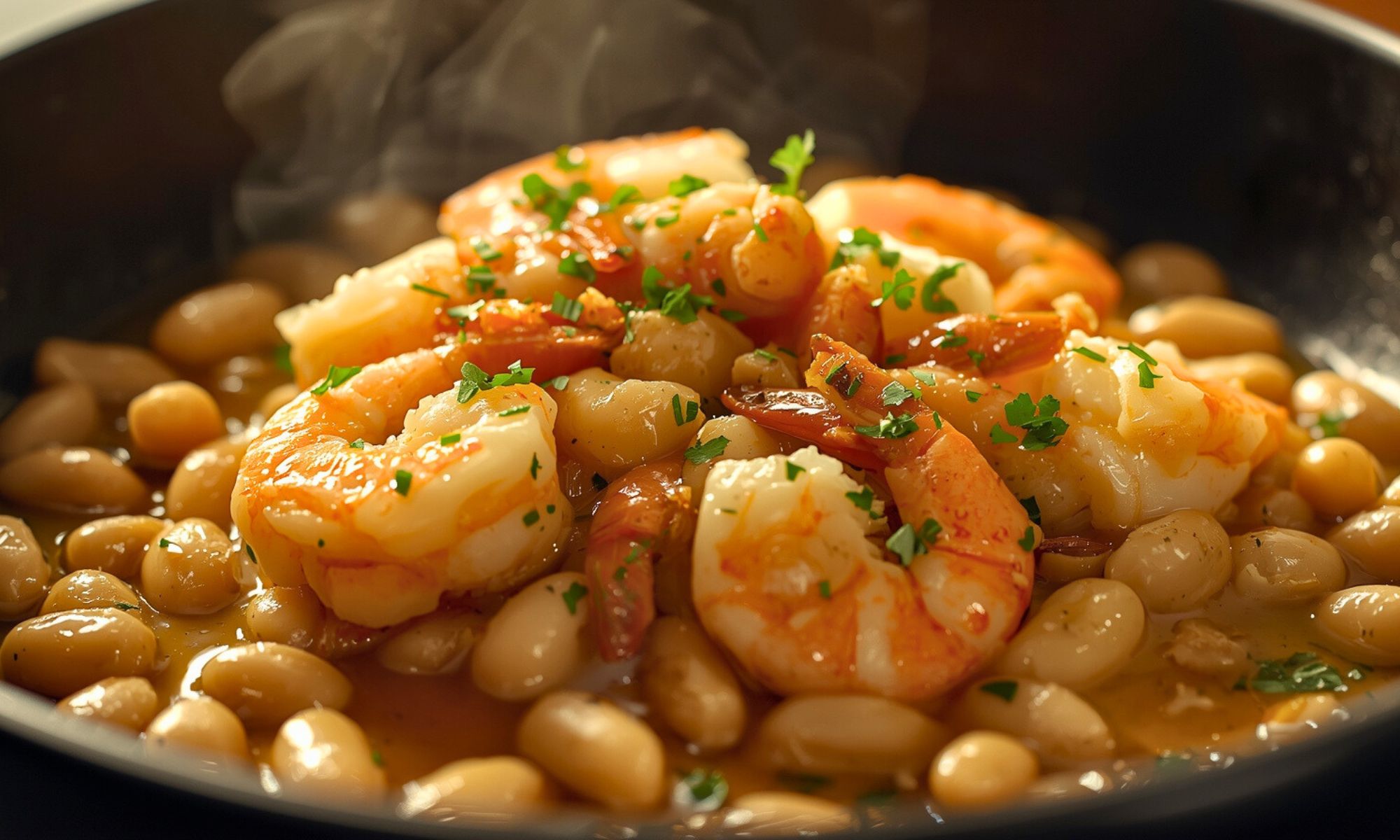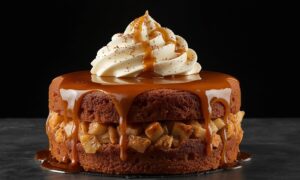Picture this: you’re standing in your kitchen at 6 PM, staring into the fridge with that familiar “what’s for dinner?” panic creeping in. Then you remember that magical combination your Italian neighbor Maria whispered about over the garden fence last spring. Two humble ingredients that, when brought together with just the right touch, create something that’ll make your family forget all about takeout forever.
Shrimp and white beans isn’t just another recipe, it’s pure kitchen alchemy. This dish transforms simple pantry staples into restaurant worthy comfort food that’s gonna surprise the heck out of everyone at your table. The creamy beans cradle perfectly seasoned shrimp in a symphony of textures that’ll have people asking for your secret. And honestly? There’s something deeply satisfying about creating magic from ingredients that cost less than your morning coffee.
Here’s what nobody tells you about shrimp and white beans: it’s one of those dishes that makes you look like a culinary genius without breaking a sweat. The kind of recipe that whispers sophistication while being forgiving enough for a Tuesday night when you’re running on fumes.
The Soul of This Beautiful Dish
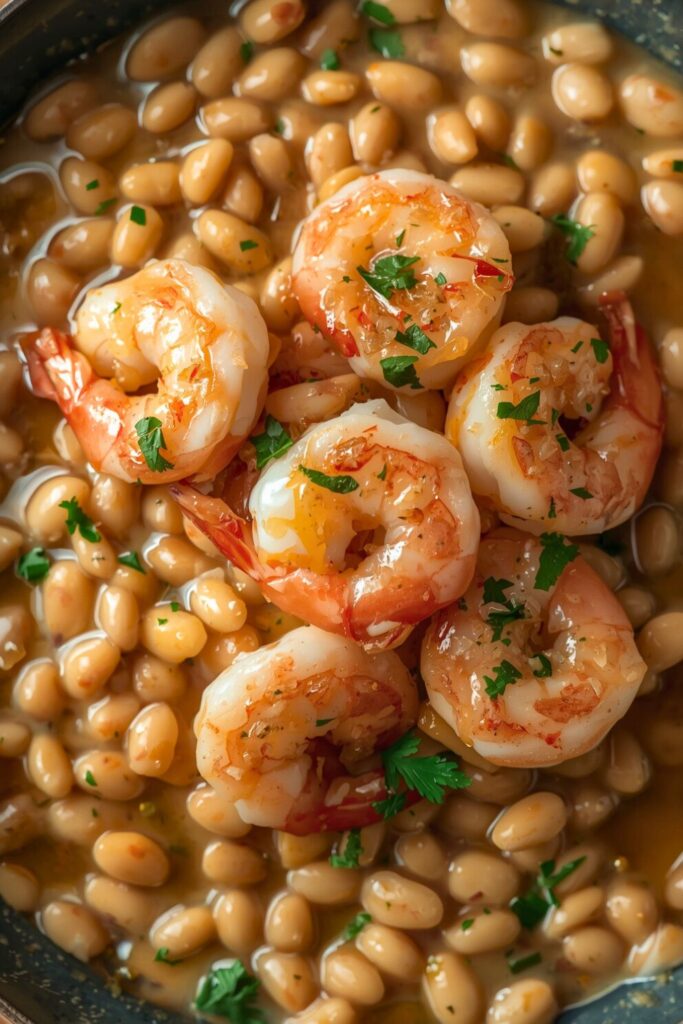
Let me tell you why this combination works so brilliantly. Shrimp brings that sweet, oceanic richness that pairs like a dream with the earthy, creamy canvas of white beans. It’s the same principle that makes surf and turf so beloved, but with a rustic, homestyle twist that feels way more approachable.
This isn’t some fancy restaurant invention either. Mediterranean cooks have been pairing seafood with legumes for centuries, creating meals that stretch protein while delivering maximum flavor. Think of it as comfort food with a passport, familiar enough to feel like home, exotic enough to feel special.
The beauty lies in the contrast. Tender shrimp with their slight bounce, nestled into velvety beans that’ve absorbed all those gorgeous aromatics you’re gonna build into this dish. Every forkful delivers layers of flavor that unfold differently depending on what you emphasize.
Why Your Kitchen Needs This Recipe
Here’s the thing about shrimp and white beans, it’s ridiculously versatile. Feeling Mediterranean? Add some rosemary and lemon. Want something with Latin flair? Throw in cumin and cilantro. Craving comfort? A splash of cream and some fresh herbs will get you there.
This recipe also solves that eternal dinner dilemma: how do you create something satisfying that doesn’t require a grocery store treasure hunt? White beans are probably sitting in your pantry right now, and good shrimp is available pretty much everywhere these days.
Plus, it’s one of those rare dishes that actually gets better when you make it ahead. The flavors meld together overnight, creating something even more delicious than what you started with.
Smart Ingredient Selection
Let’s talk shrimp first, because this is where a lot of people get tripped up. You want medium to large shrimp, those tiny ones disappear into the beans, and jumbo ones can overwhelm the delicate balance. Look for shrimp that smell like the ocean (in a good way), not fishy or ammonia like.
Frozen shrimp is totally fine, and sometimes better than what’s sitting in the seafood case. Just thaw them properly, in the fridge or under cold running water. Never, ever use hot water or the microwave. Trust me on this one.
For the beans, you’ve got options. Cannellini beans are the classic choice, they’re creamy and hold their shape beautifully. Great Northern beans work wonderfully too, with a slightly firmer texture. Navy beans will give you something more rustic and hearty.
If you’re starting with dried beans (which I totally recommend when you have time), soak them overnight and cook until they’re tender but not mushy. But honestly? High quality canned beans will work just fine. Rinse them well to remove that weird starchy liquid.
Essential Aromatics and Seasonings
This is where the magic really happens. Good olive oil isn’t optional here, it’s the foundation that carries all your other flavors. You don’t need the most expensive bottle, but skip the stuff that tastes like nothing.
Garlic is non-negotiable. I’m talking about real, fresh garlic that you chop yourself. Pre minced stuff in jars just doesn’t have that sharp, pungent bite that makes this dish sing. Plan on using more than you think you need.
Fresh herbs transform everything. Parsley adds brightness, rosemary brings earthiness, thyme offers subtle floral notes. Choose what speaks to your taste buds, but don’t skip fresh herbs entirely.
Mastering the Shrimp and White Beans Technique
Here’s where I’m gonna share the secrets that separate good cooks from great ones. The key to perfect shrimp and white beans lies in building layers of flavor and understanding timing.
Start by heating your olive oil until it shimmers but doesn’t smoke. This is your flavor base, and you want it hot enough to bloom your aromatics without burning them. Add your garlic and cook until fragrant, about 30 seconds max. Push it too far and you’ll get bitter, burnt garlic that’ll ruin everything.
The shrimp goes in next, and here’s the crucial part: don’t overcrowd the pan. Cook them in batches if necessary. You want each shrimp to have contact with the hot surface so they develop that beautiful golden sear. Flip them once, they’ll curl up and turn pink in about 2-3 minutes per side.
Remove the shrimp immediately once they’re cooked. They’ll finish cooking when you combine everything later, and overcooked shrimp is rubbery shrimp. Nobody wants that.
Building the Bean Base
Now you’re gonna create the creamy, flavorful foundation for your shrimp. Add your beans to that same pan with all those gorgeous fond bits from the shrimp. If you’re using canned beans, add some of the liquid, it’s got great flavor and helps create a silky sauce.
This is where you can get creative with additional flavors. A splash of white wine adds acidity and depth. Chicken or vegetable stock creates richness. Even just bean cooking liquid or pasta water works beautifully.
Let everything simmer gently, mashing some of the beans against the side of the pan to create natural thickening. You want some beans to break down while others stay whole, this texture contrast is what makes the dish so satisfying.
Season as you go. Taste, adjust, taste again. Salt and pepper are obvious, but consider red pepper flakes for heat, lemon zest for brightness, or a splash of good vinegar at the end to wake everything up.
The Perfect Marriage
Return your shrimp to the pan for just long enough to heat through and let the flavors meld. This is not the time to walk away, you want them warmed but still tender.
Finish with fresh herbs, a drizzle of your best olive oil, and maybe a squeeze of lemon. The dish should look vibrant and inviting, with the pink shrimp nestled beautifully in the creamy white beans.
The Science Behind the Magic
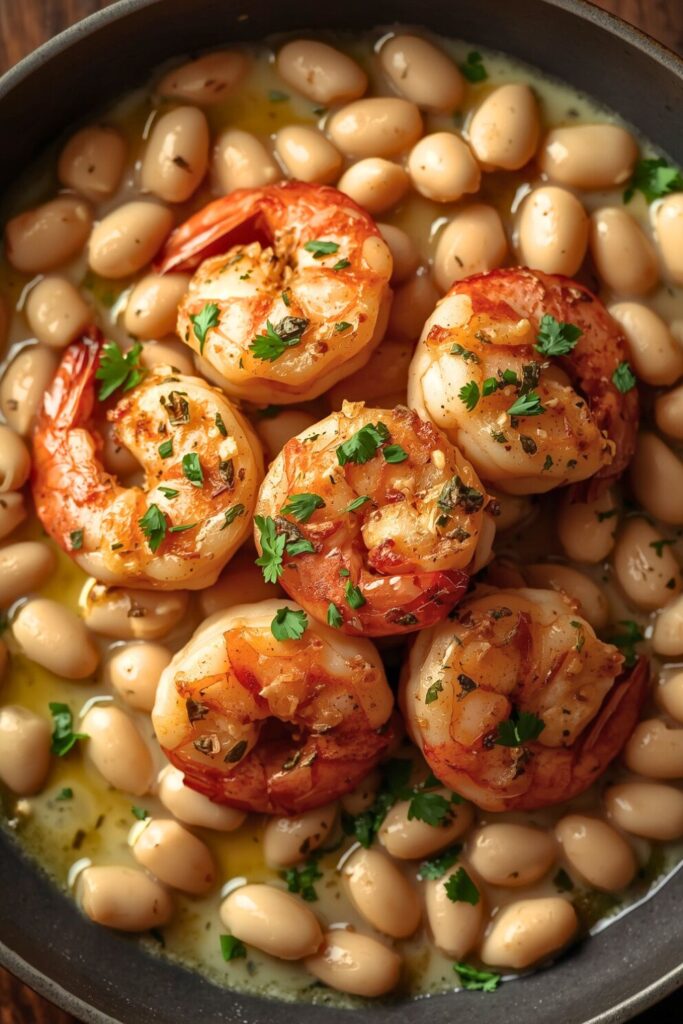
Understanding what’s happening chemically makes you a better cook. When you sear shrimp properly, you’re creating the Maillard reaction, that browning that develops complex, savory flavors. It’s the same process that makes bread crusts golden and steaks delicious.
The beans are doing their own magic trick. As they simmer, some break down and release starch, which naturally thickens your sauce. This creates that silky, restaurant quality texture without adding cream or flour.
Garlic and olive oil form the base of sofrito, a flavor technique used throughout the Mediterranean. When you heat them together gently, the garlic infuses the oil, creating a aromatic foundation that penetrates every component of your dish.
Cultural Connections
This combination appears in various forms throughout coastal Mediterranean regions. In Italy, it might be “fagioli con gamberi.” Spanish cooks create variations with marcona almonds and sherry. Greek versions often include tomatoes and feta.
Each culture brings its own twist, but the fundamental principle remains: seafood and legumes create satisfying, economical meals that stretch ingredients while maximizing flavor. It’s peasant food elevated to art.
The technique also reflects smart cooking principles. Proteins cook quickly and can become tough, while beans benefit from slow, gentle cooking. By cooking them separately and combining at the end, you get the best of both worlds.
Presentation That Wows
Great food deserves great presentation, but that doesn’t mean complicated. Start with warmed bowls, this keeps your shrimp and white beans at the perfect temperature while your family gathers around the table.
Ladle the beans first, creating a creamy foundation. Arrange the shrimp on top, making sure each serving gets an equal share. Drizzle with your best olive oil and sprinkle with fresh herbs. The contrast of pink shrimp against creamy white beans is naturally beautiful.
Consider adding a lemon wedge to each bowl. The bright yellow adds color, and that fresh citrus brightness can really make the flavors pop. Some crusty bread on the side turns this into a complete meal.
Perfect Pairings
This dish plays beautifully with others. A crisp white wine like Pinot Grigio or Sancerre complements the seafood without overpowering the delicate flavors. If you prefer reds, go light, a Chianti Classico or Côtes du Rhône works wonderfully.
For sides, keep things simple. A dressed green salad with peppery arugula cuts through the richness. Roasted vegetables like asparagus or zucchini add color and nutrition without competing for attention.
Crusty bread isn’t just recommended, it’s essential. You’ll want something to soak up every drop of that flavorful bean sauce. A good sourdough or country bread, warmed in the oven, makes this feel like a special occasion.
Making It Your Own
Once you’ve mastered the basic technique, the variations are endless. Mediterranean versions might include sun dried tomatoes, olives, and fresh basil. Spanish inspired takes could feature smoked paprika and marcona almonds.
For something heartier, add diced pancetta or chorizo at the beginning. The rendered fat adds incredible flavor to your aromatics. Vegetarians can achieve similar depth with mushrooms or roasted peppers.
Spice lovers should experiment with harissa, chipotle, or fresh jalapeños. The creamy beans provide a perfect canvas for heat, mellowing sharp spices while letting their flavors shine through.
Seasonal Adaptations
Spring versions might include fresh peas, asparagus tips, or baby spinach stirred in at the end. Summer calls for fresh tomatoes, basil, and maybe some corn kernels for sweetness.
Fall and winter adaptations could feature roasted butternut squash, sage, or even some crispy prosciutto. The key is balancing flavors and textures while keeping the shrimp and white beans as your stars.
Don’t forget about different bean varieties either. Black eyed peas create a Southern vibe, while chickpeas bring Middle Eastern flavors. Each legume brings its own personality to the dish.
Troubleshooting Common Issues
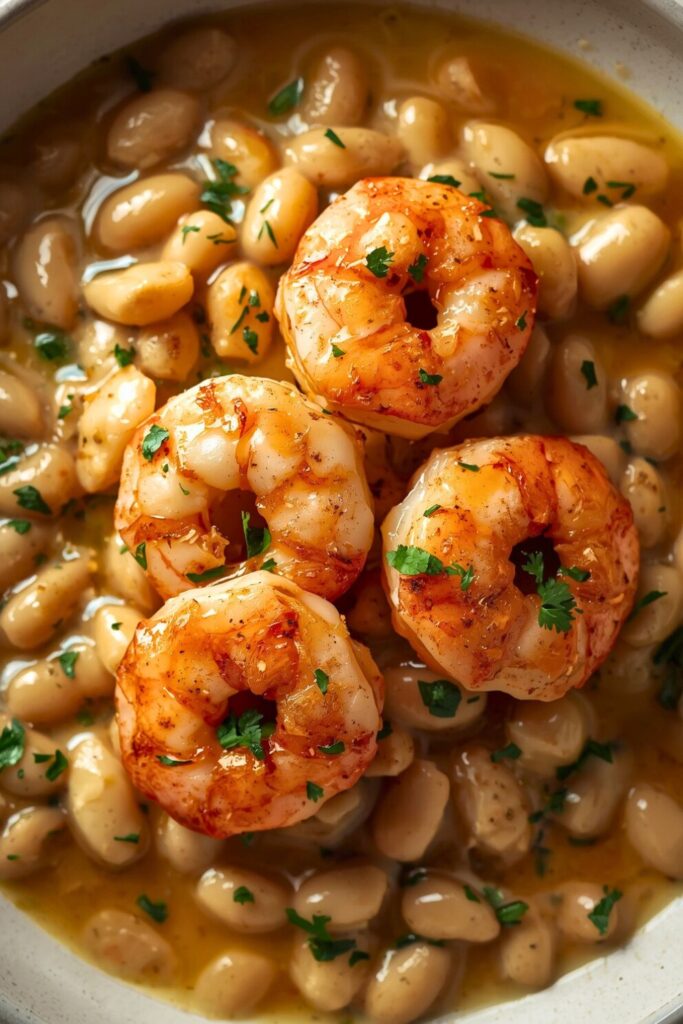
Let’s talk about what can go wrong and how to fix it. Rubbery shrimp is the biggest culprit, they cook fast and don’t forgive overcooking. When in doubt, undercook slightly. They’ll finish in the residual heat.
If your beans are too watery, simmer uncovered to reduce the liquid. Too thick? Add warm stock or pasta water gradually until you reach the right consistency. The texture should be creamy but not gluey.
Bland flavors usually mean you need more seasoning. Don’t forget that beans absorb a lot of salt, so season generously. A splash of acid at the end, lemon juice, vinegar, or white wine, brightens everything up.
Storage and Reheating
This dish keeps beautifully for 3-4 days in the refrigerator, and honestly, it often tastes better the next day. The flavors have time to meld and develop complexity you can’t achieve in a single cooking session.
Reheat gently on the stovetop with a splash of stock or water to loosen the consistency. Microwaving works in a pinch, but stir frequently and don’t overheat the shrimp.
You can prepare the bean base ahead of time and add freshly cooked shrimp just before serving. This makes it perfect for entertaining, all the prep work is done, but everything tastes fresh.
Frequently Asked Questions
Can I use different types of beans in this recipe?
Absolutely! While cannellini beans are traditional, great northern, navy, or even chickpeas work beautifully. Each brings a slightly different texture and flavor profile. Black beans create a stunning visual contrast, while butter beans add extra creaminess. Just adjust cooking times accordingly, some beans hold their shape better than others.
What’s the best way to avoid overcooked shrimp?
The secret is high heat and short cooking time. Shrimp should go from translucent to pink and opaque in just 2-3 minutes per side. Remove them immediately and let residual heat finish the job when you combine everything. If they curl into tight C shapes, they’re overcooked. Gentle curves are what you’re aiming for.
Can I make this dish ahead of time for entertaining?
This is actually perfect make ahead food! Prepare the bean base completely and store it refrigerated for up to three days. When ready to serve, reheat the beans gently and add freshly cooked shrimp. This way you get all the complex flavors of slow cooked beans with perfectly tender shrimp. Your guests will think you’re a kitchen magician.
What should I do if my sauce is too thin or too thick?
Thin sauce needs time and gentle heat to reduce, or you can mash more beans against the pan sides to release their natural starches. For thick sauce, add warm stock, pasta water, or bean cooking liquid gradually while stirring. The consistency should coat the back of a spoon but still flow easily.
Are frozen shrimp really as good as fresh for this recipe?
Often they’re better! Most “fresh” shrimp at grocery stores were previously frozen anyway. Individually frozen shrimp let you use exactly what you need and often have better texture than thawed shrimp sitting in display cases. Just thaw them properly, overnight in the fridge or under cold running water, and you’ll get excellent results.
Bringing It All Together
There’s something deeply satisfying about creating restaurant quality shrimp and white beans in your own kitchen. This isn’t just a recipe, it’s your gateway to understanding how simple ingredients become extraordinary when treated with respect and technique.
The beauty lies in its adaptability. Master the basic method, then make it yours with different herbs, spices, or seasonal additions. Each time you cook it, you’ll discover new nuances and develop your own signature touches.
Most importantly, this dish proves that great cooking doesn’t require exotic ingredients or complicated techniques. It requires understanding your ingredients, building flavors thoughtfully, and trusting the process. When you nail that perfect balance of tender shrimp and creamy beans, you’ll understand why this combination has satisfied cooks and families for generations.
So grab your favorite pan, pour yourself a glass of wine, and get ready to create something beautiful. Your kitchen, and your family, will thank you.

Swiftly Captions by Tina Smith — Quick, flavorful food recipes made simple, bringing fresh inspiration to your kitchen every day
